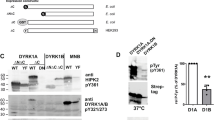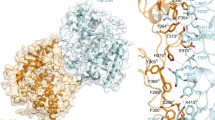Abstract
Serine (Ser)/threonine (Thr) or tyrosine (Tyr) protein kinases in eukaryotes contain RDxKxxN or RDx(A/R)A(A/R)N sequences, respectively, in the catalytic loop. Myxococcus xanthus DspB is a dual-specificity kinase that contains an atypical sequence, RDVAQKN, in the catalytic loop. The DspB mutant (A165K), which contains the canonical RDxKxxN motif, had an approximate 1.3-fold increase in kinase activity toward myelin basic protein (MBP). Arginine–aspartate (RD) kinases carry a conserved Arg immediately preceding the catalytic Asp that is required for autophosphorylation of the activation loop. DspB belongs to the RD kinase family and contains one Ser residue (Ser-190) and one Thr residue (Thr-194) in the activation loop. Mutation of Ser-190 or Thr-194 to Ala did not significantly affect the kinase activity toward MBP. We previously reported that four M. xanthus eukaryotic-like kinases (EPKs) are autophosphorylated on Tyr residues. These EPKs contain six Tyr residues at homologous positions, and five of those Tyr residues, Y25, Y102, Y145, Y173, and Y205, are conserved in DspB. DspB is mainly autophosphorylated on Y145, and a Y145F mutant has reduced kinase activity, suggesting that autophosphorylation of the Tyr residue of DspB may be required for high-level kinase activity.






Similar content being viewed by others

References
Adler K, Gerisch G, Von Hugo U, Lupas A, Schweiger A (1996) Classification of tyrosine kinases from Dictyostelium discoideum with two distinct, complete or incomplete catalytic domains. FEBS Lett 395:286–292
Akiyama T, Ishida I, Nakagawa S, Ogawara H, Watanabe S, Itoh N, Shibuya M, Fukami Y (1987) Genistein, a specific inhibitor of tyrosine-specific protein kinases. J Biol Chem 262:5592–5595
Arber S, Barbayannis FA, Hanser H, Schneider C, Stanyon CA, Bernard O, Caroni P (1998) Regulation of actin dynamics through phosphorylation of cofilin by LIM-kinase. Nature 393:805–809
Arora G, Sajid A, Arulanandh MD, Singhal A, Mattoo AR, Pomerantsev AP, Leppia SH, Maiti S, Singh Y (2012) Unveiling the novel dual specificity protein kinases in Bacillus anthracis: identification of the first prokaryotic dual specificity tyrosine phosphorylation-regulated kinase (DYRK)-like kinase. J Biol Chem 287:26749–26763
Av-Gay Y, Jamil S, Drews SJ (1999) Expression and characterization of the Mycobacterium tuberculosis serine/threonine protein Kinase PknB. Infect Immun 67:5676–5682
Boitel B, Ortiz-Lombardía M, Durán R, Pompeo F, Cole ST, Cerveñansky C, Alzari PM (2003) PknB kinase activity is regulated by phosphorylation in two Thr residues and dephosphorylation by PstP, the cognate phospho-Ser/Thr phosphatase, in Mycobacterium tuberculosis. Mol Microbiol 49:1493–1508
Eichholtz T, de Bont DB, de Widt J, Liskamp RM, Ploegh HL (1993) A myristoylated pseudosubstrate peptide, a novel protein kinase C inhibitor. J Biol Chem 268:1982–1986
Gibbs CS, Zoller MJ (1991) Rational scanning mutagenesis of a protein kinase identifies functional regions involved in catalysis and substrate interactions. J Biol Chem 266:8923–8931
Grant BD, Hemmer W, Tsigelny I, Adams JA, Taylor SS (1998) Kinetic analyses of mutations in the glycine-rich loop of cAMP-dependent protein kinase. Biochemistry 37:7708–7715
Hanke JH, Gardner JP, Dow RL, Changelian PS, Brissette WH, Weringer EJ, Pollok BA, Connelly PA (1996) Discovery of a novel, potent, and Src family-selective tyrosine kinase inhibitor. Study of Lck- and FynT-dependent T cell activation. J Biol Chem 271:695–701
Hanks SK (2003) Genomic analysis of the eukaryotic protein kinase superfamily: a perspective. Genome Biol 4:111
Hanks SK, Quinn AM, Hunter T (1988) The protein kinase family: conserved features and deduced phylogeny of the catalytic domains. Science 241:42–52
Hastie CJ, McLauchlan HJ, Cohen P (2006) Assay of protein kinases using radiolabeled ATP: a protocol. Nat Protoc 1:968–971
Hug H, Sarre TF (1993) Protein kinase C isozymes: divergence in signal transduction. Biochem J 291:329–343
Johnson LN, Noble MEM, Owen DJ (1996) Active and inactive protein kinases: structural basis for regulation. Cell 85:149–158
Kemp BE, Pearson RB, House CM (1991) Pseudosubstrate-based peptide inhibitors. Methods Enzymol 201:287–304
Kim L, Liu J, Kimmel AR (1999) The novel tyrosine kinase ZAK1 activates GSK3 to direct cell fate specification. Cell 99:399–408
Kimura Y, Yamashita S, Mori Y, Kitajima Y, Takegawa K (2011) A Myxococcus xanthus bacterial tyrosine kinase, BtkA, is required for the formation of mature spores. J Bacteriol 193:5853–5857
Kimura Y, Kato T, Mori Y (2012) Function analysis of a bacterial tyrosine kinase, BtkB, in Myxococcus xanthus. FEMS Microbiol Lett 336:45–51
Kimura Y, Urata M, Okamoto R (2015) Characterizing activities of eukaryotic-like protein kinases with atypical catalytic loop motifs from Myxococcus xanthus. J Biosci Bioeng 119:511–514
Konishi H, Tanaka M, Takemura Y, Matsuzaki H, Ono Y, Kikkawa U, Nishizawa Y (1997) Activation of protein kinase C by tyrosine phosphorylation in response to H2O2. Proc Natl Acad Sci USA 94:11233–11237
Kozma SC, Ferrari S, Bassand P, Siegmann M, Totty N, Thomas G (1990) Cloning of the mitogen-activated S6 kinase from rat liver reveals an enzyme of the second messenger subfamily. Proc Natl Acad Sci USA 87:7356–7369
Madhusudan AP, Xuong NH, Taylor SS (2002) Crystal structure of a transition state mimic of the catalytic subunit of cAMP-dependent protein kinase. Nat Struct Biol 9:273–277
Mori Y, Maeda M, Takegawa K, Kimura Y (2012) PhpA, a tyrosine phosphatase of Myxococcus xanthus, is involved in the production of exopolysaccharide. Microbiology 158:2546–2555
Muñoz-Dorado J, Inouye S, Inouye M (1991) A gene encoding a protein serine/threonine kinase is required for normal development of M. xanthus, a gram-negative bacterium. Cell 67:995–1006
Okamoto R, Urata M, Takegawa K, Kimura Y (2014) Regulation of eukaryotic-like protein kinase activity of DspA from Myxococcus xanthus by autophosphorylation. J Biochem 155:99–106
Pereira SF, Goss L, Dworkin J (2011) Eukaryote-like serine/threonine kinases and phosphatases in bacteria. Microbiol Mol Biol Rev 75:192–212
Pérez J, Castañeda-García A, Jenke-Kodama H, Müller R, Muñoz-Dorado J (2008) Eukaryotic-like protein kinases in the prokaryotes and the myxobacterial kinome. Proc Natl Acad Sci USA 14:15950–15955
Reichenbach H (1999) The ecology of the myxobacteria. Environ Microbiol 1:15–21
Sasaki M, Takegawa K, Kimura Y (2014) Enzymatic characteristics of an ApaH-like phosphatase, PrpA, and a diadenosine tetraphosphate hydrolase, ApaH, from Myxococcus xanthus. FEBS Lett 588:3395–3402
Steichen JM, Kuchinskas M, Keshwani MM, Yang J, Adams JA, Taylor SS (2012) Structural basis for the regulation of protein kinase A by activation loop phosphorylation. J Biol Chem 287:14672–14680
Sun M, Wartel M, Cascales E, Shaevitz JW, Mignot T (2011) Motor-driven intracellular transport powers bacterial gliding motility. Proc Natl Acad Sci USA 108:7559–7564
Tan JL, Spudich JA (1990) Developmentally regulated protein-tyrosine kinase genes in Dictyostelium discoideum. Mol Cell Biology 10:3578–3583
Thomasson B, Link J, Stassinopoulos AG, Burke N, Plamann L, Hartzell PL (2002) MglA, a small GTPase, interacts with a tyrosine kinase to control type IV pili-mediated motility and development of Myxococcus xanthus. Mol Microbiol 46:1399–1413
Toshima J, Ohashi K, Okano I, Nunoue K, Kishioka M, Kuma K, Miyata T, Hirai M, Baba T, Mizuno K (1995) Identification and characterization of a novel protein kinase, TESK1, Specifically expressed in testicular germ cells. J Biol Chem 270:31331–31337
Ubersax JA, Ferrell JE Jr (2007) Mechanisms of specificity in protein phosphorylation. Nat Rev Mol Cell Biol 8:530–541
Whitworth DE (2007) Myxobacteria: multicellularity and differentiation. ASM Press, Washington, DC
Acknowledgments
This study was supported by Grants-in-Aid for Scientific Research from the Ministry of Education, Culture, Sports, Science and Technology of Japan (25440087).
Author information
Authors and Affiliations
Corresponding author
Additional information
Communicated by Erko Stackebrandt.
Electronic supplementary material
Below is the link to the electronic supplementary material.
Fig. S1
Primary sequence alignment between five M. xanthus EPKs that autophosphorylate tyrosine. Tyrosine residues in agreement for more than three sequences are indicated by bold type. Amino acid residues in agreement between the five sequences are indicated by asterisks. The location of tyrosine residues in DspB is shown by amino acid numbers (PDF 117 kb)
Rights and permissions
About this article
Cite this article
Kimura, Y., Urata, M. Characterization of a eukaryotic-like protein kinase, DspB, with an atypical catalytic loop motif from Myxococcus xanthus . Arch Microbiol 198, 219–226 (2016). https://doi.org/10.1007/s00203-015-1181-5
Received:
Revised:
Accepted:
Published:
Issue Date:
DOI: https://doi.org/10.1007/s00203-015-1181-5



